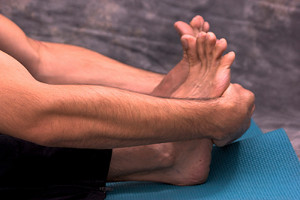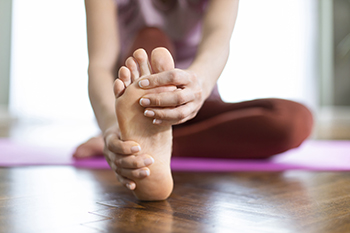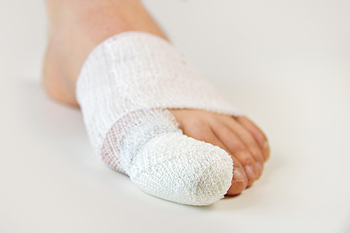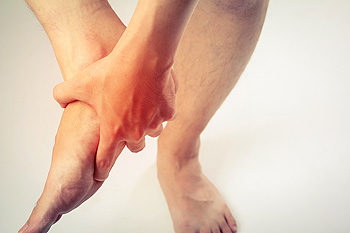January 2024
Foot Stretching May Help to Maintain Flexibility

Cultivating flexibility in the feet is a fundamental, yet often overlooked, aspect of maintaining overall foot health and preventing injuries. Stretching the feet not only enhances their range of motion but also helps in strengthening the muscles and tendons, thereby reducing the risk of injuries. Incorporating regular foot stretches into one's routine can contribute to improved flexibility, aiding the foot's adaptability to various movements. Flexible feet are better equipped to absorb shock and distribute pressure evenly during activities, mitigating the strain on joints and reducing the likelihood of injuries, such as sprains or stress fractures. Stretching exercises also promote better circulation and alleviate muscle tightness, fostering a more resilient foundation for the entire body. For information on foot stretches and how to perform them, it is suggested that you confer with a podiatrist.
Stretching the feet is a great way to prevent injuries. If you have any concerns with your feet consult with one of our doctors from Coral Desert Foot & Ankle. Our doctors will assess your condition and provide you with quality foot and ankle treatment.
Stretching the Feet
Stretching the muscles in the foot is an important part in any physical activity. Feet that are tight can lead to less flexibility and make you more prone to injury. One of the most common forms of foot pain, plantar fasciitis, can be stretched out to help ease the pain. Stretching can not only ease pain from plantar fasciitis but also prevent it as well. However, it is important to see a podiatrist first if stretching is right for you. Podiatrists can also recommend other ways to stretch your feet. Once you know whether stretching is right for you, here are some excellent stretches you can do.
- Using a foam roller or any cylindrical object (a water bottle or soda can will do), roll the object under your foot back and forth. You should also exert pressure on the object. Be sure to do this to both feet for a minute. Do this exercise three times each.
- Similar to the previous one, take a ball, such as a tennis ball, and roll it under your foot while seated and exert pressure on it.
- Grab a resistance band or towel and take a seat. If you are using a towel, fold it length wise. Next put either one between the ball of your foot and heel and pull with both hands on each side towards you. Hold this for 15 seconds and then switch feet. Do this three times for each foot.
- Finally hold your big toe while crossing one leg over the other. Pull the toe towards you and hold for 15 seconds. Once again do this three times per foot.
It is best to go easy when first stretching your foot and work your way up. If your foot starts hurting, stop exercising and ice and rest the foot. It is advised to then see a podiatrist for help.
If you have any questions, please feel free to contact one of our offices located in St. George and Kanab, UT, and Mesquite, NV . We offer the newest diagnostic and treatment technologies for all your foot care needs.
Vegetable Choices for Gout Patients

Gout, a form of arthritis caused by the accumulation of uric acid crystals in the joints, necessitates careful consideration of dietary choices, including vegetable consumption. Opting for vegetables rich in fiber and low in purines is key for managing gout. Leafy greens such as kale, spinach, and swiss chard are excellent choices, offering essential nutrients without significantly impacting uric acid levels. Cruciferous vegetables like broccoli and cauliflower also make gout-friendly additions to the plate. However, moderation is advised with certain vegetables high in purines, such as asparagus and mushrooms, as they may contribute to uric acid buildup. If you have experienced one or more gout attacks, it is strongly suggested that you are under the care of a podiatrist who can help you to manage this condition, including discussing appropriate food choices.
Gout is a painful condition that can be treated. If you are seeking treatment, contact one of our doctors from Coral Desert Foot & Ankle. Our doctors will treat your foot and ankle needs.
What Is Gout?
Gout is a form of arthritis that is characterized by sudden, severe attacks of pain, redness, and tenderness in the joints. The condition usually affects the joint at the base of the big toe. A gout attack can occur at any random time, such as the middle of the night while you are asleep.
Symptoms
- Intense Joint Pain - Usually around the large joint of your big toe, and it most severe within the first four to twelve hours
- Lingering Discomfort - Joint discomfort may last from a few days to a few weeks
- Inflammation and Redness -Affected joints may become swollen, tender, warm and red
- Limited Range of Motion - May experience a decrease in joint mobility
Risk Factors
- Genetics - If family members have gout, you’re more likely to have it
- Medications - Diuretic medications can raise uric acid levels
- Gender/Age - Gout is more common in men until the age of 60. It is believed that estrogen protects women until that point
- Diet - Eating red meat and shellfish increases your risk
- Alcohol - Having more than two alcoholic drinks per day increases your risk
- Obesity - Obese people are at a higher risk for gout
Prior to visiting your podiatrist to receive treatment for gout, there are a few things you should do beforehand. If you have gout you should write down your symptoms--including when they started and how often you experience them, important medical information you may have, and any questions you may have. Writing down these three things will help your podiatrist in assessing your specific situation so that he or she may provide the best route of treatment for you.
If you have any questions, please feel free to contact one of our offices located in St. George and Kanab, UT, and Mesquite, NV . We offer the newest diagnostic and treatment technologies for all your foot care needs.
Lump on the Bottom of the Foot

A lump on the bottom of your foot can lead to discomfort and hinder your daily activities. Among the most common causes of bumps or lumps under the foot are plantar fibromas. These bumps are firm and rubbery nodules that form under the arch. While often painless, plantar fibromas can feel like a stone in the shoe while walking. Calluses, resulting from thickened skin, typically around toes and the ball of the foot, are usually painless and are manageable with proper footwear, creams, and orthotics. Bone spurs, caused by abnormal bone growth due to friction or stress can form hard lumps under the foot. They can be painful, especially during walking, and may require exercises, orthotics, medications, or surgery. Plantar warts, caused by the human papillomavirus, or HPV, result in painful, skin-colored bumps. They respond slowly to treatments like salicylic acid, cryotherapy, or surgery. Additional causes of bumps under the foot include cysts, sesamoiditis, gout, and plantar fasciitis, each requiring specific diagnostic approaches and treatments. If you encounter persistent discomfort or notice a new lump on the bottom of your foot, it is suggested that you schedule an appointment with a podiatrist for an exam and a diagnosis. Treatment options will follow.
Foot Pain
Foot pain can be extremely painful and debilitating. If you have a foot pain, consult with one of our doctors from Coral Desert Foot & Ankle. Our doctors will assess your condition and provide you with quality foot and ankle treatment.
Causes
Foot pain is a very broad condition that could be caused by one or more ailments. The most common include:
- Bunions
- Hammertoes
- Plantar Fasciitis
- Bone Spurs
- Corns
- Tarsal Tunnel Syndrome
- Ingrown Toenails
- Arthritis (such as Gout, Rheumatoid, and Osteoarthritis)
- Flat Feet
- Injury (from stress fractures, broken toe, foot, ankle, Achilles tendon ruptures, and sprains)
- And more
Diagnosis
To figure out the cause of foot pain, podiatrists utilize several different methods. This can range from simple visual inspections and sensation tests to X-rays and MRI scans. Prior medical history, family medical history, and any recent physical traumatic events will all be taken into consideration for a proper diagnosis.
Treatment
Treatment depends upon the cause of the foot pain. Whether it is resting, staying off the foot, or having surgery; podiatrists have a number of treatment options available for foot pain.
If you have any questions, please feel free to contact one of our offices located in St. George and Kanab, UT, and Mesquite, NV . We offer the newest diagnostic and treatment technologies for all your foot care needs.
Managing a Broken Toe

Managing a broken toe can be a painful experience. A broken toe often results from accidentally stubbing it or dropping a heavy object on it. The toes, composed of two or three tiny bones, can incur fractures when subjected to such incidents. Symptoms of a broken toe can include pain, swelling, and potential discoloration of the toenail due to trapped blood. In the event of a toe fracture, a podiatrist typically treats it by buddy taping, where the broken toe is taped to the adjacent one for added support during the healing process. Additionally, wearing comfortable and roomy shoes is recommended to alleviate pressure on the injured toe. If blood is trapped under the toenail, a podiatrist may make a small hole to drain it and ease discomfort. It is important to note that broken toes rarely require realignment, and with proper care, including buddy taping and wearing appropriate footwear, a steady recovery is generally expected. If you suspect a broken toe, it is suggested that you schedule an appointment with a podiatrist for a treatment plan specific to the severity of your injury.
Broken toes may cause a lot of pain and should be treated as soon as possible. If you have any concerns about your feet, contact one of our doctors from Coral Desert Foot & Ankle. Our doctors will treat your foot and ankle needs.
What Is a Broken Toe?
A broken toe occurs when one or more of the toe bones of the foot are broken after an injury. Injuries such as stubbing your toe or dropping a heavy object on it may cause a toe fracture.
Symptoms of a Broken Toe
- Swelling
- Pain (with/without wearing shoes)
- Stiffness
- Nail Injury
Although the injured toe should be monitored daily, it is especially important to have a podiatrist look at your toe if you have severe symptoms. Some of these symptoms include worsening or new pain that is not relieved with medication, sores, redness, or open wounds near the toe.
If you have any questions, please feel free to contact one of our offices located in St. George and Kanab, UT, and Mesquite, NV . We offer the newest diagnostic and treatment technologies for all your foot care needs.
Do You Suffer From Painful Feet?
Common Causes of Heel Pain

Heel pain is a prevalent issue that affects people of all ages, whether you are an athlete, a busy professional, or a parent. Plantar fasciitis is the most common complaint of heel pain. It occurs when excessive pressure on the feet damages the plantar fascia ligament, resulting in pain and stiffness. This condition is often associated with activities that put stress on the feet, like running or standing for extended periods. The next most common causes of heel pain are sprains and strains, which are injuries to the body. These ailments can range from minor to severe and are often the result of physical activities or accidents. A fractured heel can be caused by accidents, falls, or severe trauma. This is considered a medical emergency and requires urgent care. If you experience sudden, severe pain in your heel, in addition to swelling and difficulty bearing weight, it is beneficial to seek immediate medical attention. Achilles tendonitis is another common reason for heel pain, caused when the tendon connecting the calf muscles to the heel becomes inflamed due to overuse injuries. Finally, bursitis is an inflammation of the fluid filled sacs surrounding joints, where tendons, skin, and muscle tissues meet bones. It can lead to heel pain and discomfort. If you have any type of heel pain that inhibits your daily life, it is suggested that you make an appointment with a podiatrist for a diagnosis and treatment options.
Many people suffer from bouts of heel pain. For more information, contact one of our doctors of Coral Desert Foot & Ankle. Our doctors can provide the care you need to keep you pain-free and on your feet.
Causes of Heel Pain
Heel pain is often associated with plantar fasciitis. The plantar fascia is a band of tissues that extends along the bottom of the foot. A rip or tear in this ligament can cause inflammation of the tissue.
Achilles tendonitis is another cause of heel pain. Inflammation of the Achilles tendon will cause pain from fractures and muscle tearing. Lack of flexibility is also another symptom.
Heel spurs are another cause of pain. When the tissues of the plantar fascia undergo a great deal of stress, it can lead to ligament separation from the heel bone, causing heel spurs.
Why Might Heel Pain Occur?
- Wearing ill-fitting shoes
- Wearing non-supportive shoes
- Weight change
- Excessive running
Treatments
Heel pain should be treated as soon as possible for immediate results. Keeping your feet in a stress-free environment will help. If you suffer from Achilles tendonitis or plantar fasciitis, applying ice will reduce the swelling. Stretching before an exercise like running will help the muscles. Using all these tips will help make heel pain a condition of the past.
If you have any questions please contact one of our offices located in St. George and Kanab, UT, and Mesquite, NV . We offer the newest diagnostic and treatment technologies for all your foot and ankle needs.





